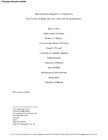Measuring time perspective in adolescents: Can you get the right answer by asking the wrong questions? (Pre-published version)
Citation
McKay, M.T., Perry, J.L., Worrell, F.C., Živkovič, U., Mello, Z.R., & Musil, B. (2015) 'Measuring time perspective in adolescents : Can you get the right answer by asking the wrong questions?' Personality and Individual Differences 78(1), pp. 53-57. DOI: 10.1016/j.paid.2015.01.015

View/
Date
2015Author
Perry, John
McKay, Michael T.
Worrell, Frank C.
Zivkovic, Urška
Mello, Zena R.
Musil, Bojan
Peer Reviewed
YesMetadata
Show full item record
McKay, M.T., Perry, J.L., Worrell, F.C., Živkovič, U., Mello, Z.R., & Musil, B. (2015) 'Measuring time perspective in adolescents : Can you get the right answer by asking the wrong questions?' Personality and Individual Differences 78(1), pp. 53-57. DOI: 10.1016/j.paid.2015.01.015
Abstract
Time perspective continues to evolve as a psychological construct. The extant literature suggests that higher future orientation and lower present orientation are associated with better developmental outcomes. However, the extant literature also suggests that issues remain with the measurement of the construct. Recently, a 25-item version of the Zimbardo Time Perspective Inventory (ZTPI-25) was suggested for use based on high internal consistency estimates and good discriminant validity of scores in a sample of Italian adolescents. However, the genesis of this scale is uncertain. The present study examined the factorial validity, reliability, and concurrent validity of ZTPI-25 scores in Slovenian, American, and British adolescents. Results revealed satisfactory concurrent validity based on correlations with measures used in the development of the full ZTPI. However, internal consistency and factorial validity of scores were unsatisfactory. The present study questions the use of the ZTPI-25 with adolescents in the context of conceptual and measurement issues more broadly.
Keywords
Zimbardo Time Perspective InventoryExploratory structural equation modeling
Reliability
Concurrent validity

